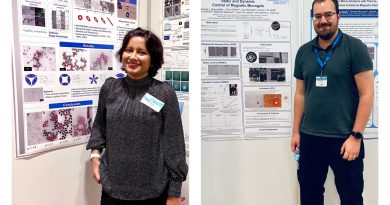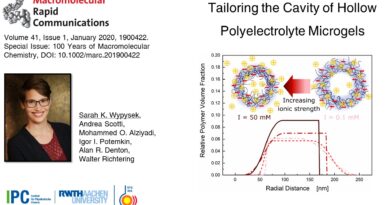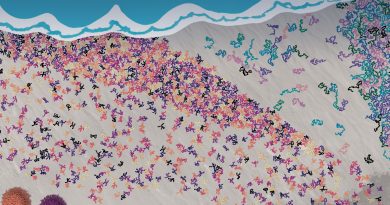SFB 985 on the cover of Macromolecules
Structure of Responsive Microgels down to Ultralow Cross-Linkings
Although microgels have been widely used as model systems for soft colloids, their properties are still far from being completely understood. This stems from their heterogeneous structure strongly differing from that of an idealized polymeric network. Indeed, microgels synthesized by conventional precipitation polymerization exhibit not only a fuzzy structure with respect to the difference of reactivity between monomers and cross-linker molecules but also static heterogeneities related to the distribution
in the length of the chains constituting their network. These features can be reproduced in computer simulations using the so-called in silico synthesis. Hereby, a designing force acting on the cross-linkers during the in silico synthesis allows us to finely adjust the radial density distribution and, thus, to reproduce both the fuzziness and local heterogeneities present in real microgel systems. In this study, poly(N-isopropylacrylamide) (PNIPAM) microgels were synthesized with different degrees of cross-linking ccross down to cross-linker free conditions corresponding to so-called ultralow cross-linked microgels (ULC microgels). The experimental characterization was accompanied by numerical simulations at different ccross with the same designing force, which is found to be independent of the cross-linker concentration, as well as the size of the microgels. For the ULC microgels, it was found that no designing force is needed, but the number density of the network is much smaller. The number of effective cross-linkers in this case is found to be ∼0.1%. The form factors of all microgels were measured at different temperatures across their volume phase transition with both static light scattering and small-angle X-ray scattering, favorably comparing them to the simulated ones. Furthermore, the swelling behavior was experimentally determined by dynamic light scattering and viscosimetry and also compared to the simulated results. Finally, experimental and simulated results indicate that the cross-linking dependence of the swelling is well-described by theoretical predictions for the isotropic swelling of an ideal network despite the highly heterogeneous character of real microgels.
Nabanita Hazra, Andrea Ninarello, Andrea Scotti, Judith E. Houston, Pablo Mota-Santiago,
Emanuela Zaccarelli, and Jérôme J. Crassous



